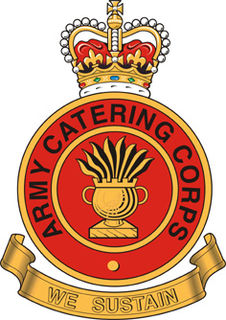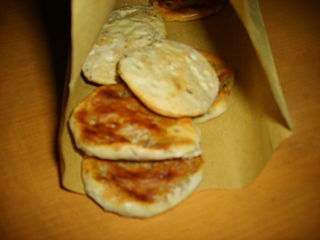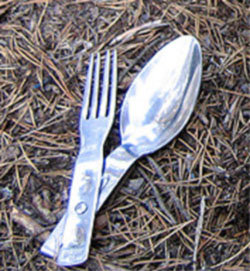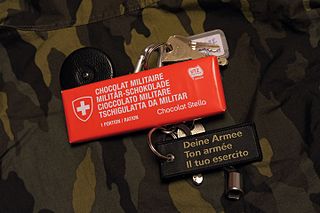 W
WA-ration is a term used in the United States armed forces for a meal provided to troops prepared using fresh, refrigerated, or frozen foods. The use of fresh, refrigerated or frozen foods distinguish 'A' rations from 'B' rations, which use canned or preserved ingredients to enable them to be served without adequate refrigeration or freezer facilities.
 W
WHardtack is a simple type of biscuit or cracker made from flour, water, and sometimes salt. Hardtack is inexpensive and long-lasting. It is used for sustenance in the absence of perishable foods, commonly during long sea voyages, land migrations, and military campaigns. Along with salt pork, hardtack was a standard ration for many militaries and navies throughout the 17th, 18th, and 19th centuries.
 W
WThe Army Catering Corps (ACC) was a corps of the British Army, responsible for the feeding of all Army units. It was formed in 1941 and amalgamated into the Royal Logistic Corps in 1993.
 W
WDining in is a formal military ceremony for members of a company or other unit, which includes a dinner, drinking, and other events to foster camaraderie and esprit de corps.
 W
WA field kitchen is a mobile kitchen, mobile canteens or food truck used primarily by militaries to provide warm food to the troops near the frontline or in temporary encampments.
 W
WA field ration is a canned or pre-packaged meal, easily prepared and consumed by military troops. They are distinguished from regular military garrison rations by virtue of being designed for minimal preparation in the field, using canned, vacuum-sealed, pre-cooked or freeze-dried foods, powdered beverage mixes and concentrated food bars, as well as for long shelf life. Most field rations typically contains meat as one of its main course. The iron ration is a soldier's dry emergency rations.
 W
WThe Field Ration Eating Device is a small device which serves as a combination of a can opener, a bottle opener, and a spoon. Introduced around 1943, it is issued to the Australian Defence Force in its CR1M ration packs. It is also humorously referred to as the "Fucking Ridiculous Eating Device".
 W
WFoods of the American Civil War were the provisions during the American Civil War with which both the Union and Confederate armies struggled to keep their soldiers provisioned adequately.
 W
WHardtack is a simple type of biscuit or cracker made from flour, water, and sometimes salt. Hardtack is inexpensive and long-lasting. It is used for sustenance in the absence of perishable foods, commonly during long sea voyages, land migrations, and military campaigns. Along with salt pork, hardtack was a standard ration for many militaries and navies throughout the 17th, 18th, and 19th centuries.
 W
WHitlerszalonna or Hitler-szalonna was a dense fruit jam, although there is debate about how much fruit was actually in it and how edible it was, that was eaten by Hungarian troops and civilians during World War II. It was made from mixed fruits such as plum and sold in brick shaped blocks held in a piece of paper rather than in a jar. These slabs were sliced, a bit like szalonna. Soldiers kept it in a case and it could be cooked with other foods. The term itself is considered slang and defined as something like "tough fruit".
 W
WHumanitarian daily rations (HDRs) are food rations manufactured in the United States intended to be supplied to civilians and other non-military personnel in humanitarian crises. Each is intended to serve as a single person's full daily food supply, and contain somewhat over 2,200 calories (9,200 kJ). They have shelf-lives of about 3 years, and their contents are designed to be acceptable to a variety of religious and ethnic groups. The meals cost approximately one-fifth of the cost of a Meal, Ready-to-Eat (MRE). The rations were first used in Bosnia in 1993.
 W
WKommissbrot, formerly Kommißbrot, is a dark type of German bread, baked from rye and other flours, historically used for military provisions.
 W
WKompia or kompyang is a bread product originates from Fuzhou, the capital city of Fujian Province of China. It is popular in Fujian and has spread to other areas including the Ryukyus, Taiwan, and parts of Southeast Asia including the Malaysian towns of Sitiawan, Sibu, Ayer Tawar, Sarikei, Bintangor and other places where the dominant Chinese community is of Fuzhou ancestry.
 W
WLusikkahaarukka or LuHa is a stainless steel, folding spoon-fork combination issued together with a mess kit in the Finnish Army. It is widely used in camping and outdoors activities.
 W
WMaconochie was a stew of sliced turnips, carrots, potatoes, onions, haricot beans and beef in a thin broth, named after the Aberdeen Maconochie Company that produced it. It was a widely used food ration for British soldiers in the field during the Boer War and in front-line trenches during World War I. There was also a French version called Maconóochie.
 W
WThe mess is an area where military personnel socialize, eat, and live. The term is also used to indicate the groups of military personnel who belong to separate messes, such as the officers' mess, the chief petty officer mess, and the enlisted mess. In some civilian societies this military usage has been extended to the eating arrangements of other disciplined services such as fire fighting and police forces.
 W
WA mess kit is a collection of silverware and cookware used during camping and backpacking, as well as extended military campaigns. There are many varieties of mess kits available to consumers, and militaries commonly provide them to their troops.
 W
WThe Military Biscuit is a food component of the Swiss army.
 W
WMilitary chocolate is a food component of the Swiss Armed Forces.
 W
WSalt pork is salt-cured pork. It is usually prepared from pork belly, or, more rarely, fatback. Salt pork typically resembles uncut side bacon, but is fattier, being made from the lowest part of the belly, saltier, as the cure is stronger and performed for longer, and never smoked.
 W
WAlexis Benoît Soyer was a French chef who became the most celebrated cook in Victorian England. He also tried to alleviate suffering of the Irish poor in the Great Irish Famine (1845–1849), and contributed a penny for the relief of the poor for every copy sold of his pamphlet The Poor Man's Regenerator (1847). He worked to improve the food provided to British soldiers in the Crimean War. A variant of the field stove he invented at that time, known as the "Soyer stove", remained in use with the British army until 1982.
 W
WTushonka is a canned stewed meat especially popular in Russia and other countries of the former Eastern Bloc. It has become a common name for different kinds of canned stewed meat, not all of which correspond to the strict GOST standards.